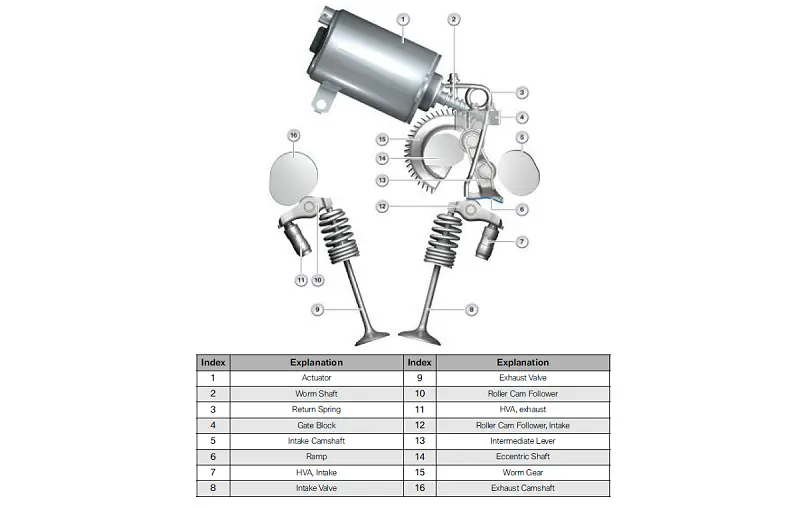Throttle bodies have been, and still are the norm for most cars out there. However, not for BMW. This brand has stepped away from the romantic notion of having a massive intake valve open when you step on the gas. Why? Because as cool as throttle bodies are, they aren’t exactly the most efficient method of getting air into the engine.
Enter BMW Valvetronic. This system is designed to make throttle bodies obsolete by moving the entry point of air a lot closer to the cylinder head. Here’s what Valvetronic is and how it works.

What is Valvetronic, and How Does It Work?
The BMW Valvetronic is essentially a variable valve lift device introduced in 2001 in order to improve the efficiency of BMW engines. Engineers at BMW have come up with an ingenious idea of regulating how much air enters their naturally aspirated engines by electronically adjusting valve lift timing.
The Valvetronic system is made of several elements:
- Valvetronic motor
- Worm gear
- The eccentric shaft
- The Intermediate arm
- Rocker arm
Here’s how all of this works. The Valvetronic motor, worm gear, and eccentric shaft sit above the camshafts in the cylinder head. Once the DME issues a command to adjust the valve lift, the motor engages the worm gear, which in turn rotates the eccentric shaft. The eccentric shaft features elements similar to cam lobes, that act on the intermediate arm and rotate it.
With the system fully disengage, the intermediate arm isn’t contacting the camshaft cam lobes. However, once the eccentric shaft is rotated, the intermediate arm is repositioned in a way that allows the camshaft lobes to come into contact with its surface.
With cam lobes now in play, the intermediate arm is driven, which further drives the rocker arm and activates the intake valves. The whole process is seen in the image above.
Benefits of BMW Valvetronic
When BMW first introduced VANOS, their variable valve timing system, it made a world of difference. However, they still needed a way to adjust the valve lift. BMW could have gone the same route as VW/Audi and solved the VVL issue by redesigning their cams to have different cam lobe profiles. That is what a large number of manufacturers did.
However, BMW wanted something more elegant, and most importantly — they wanted the ability to make finer adjustments.
Although Valvetronic is a complicated system compared to most others of its kind, it allows for infinite adjustment in combination with BMW VANOS. Valves can move from 0.18 mm lift all the way to 9.7 mm lift, in a fraction of a second, and your BMW’s DME gets to say just how far the valves open.
Atmospheric Pressure Right at the Intake Valve
There is one more huge benefit to Valvetronic, and that is the fact that you no longer need a throttle body. This isn’t to say that BMW engines fitted with Valvetronic don’t have a throttle body. They do, but the average throttle body found on these engines is small, always open and essentially made obsolete.
As the air is coming through the air filter, it doesn’t hit a wall which is usually the throttle butterfly valve. Instead, with no obstacles in the way, the air goes all the way into the intake and stops right in front of the intake valves. In other words, there is atmospheric pressure right at the cylinder head, which means that your intake valves can grab air immediately as they open.
Doing things this way improves efficiency, and fuel/air atomization, and removes the minute amount of lag caused by the air having to travel all the way from the throttle body area before it reaches the intake valves.
Valvetronic Issues

Photo credit AcureTech YouTube
Like any other complex system, Valvetronic is known to fail from time to time. There are too many moving parts and too many sensors in there. There are generally two ways this system can malfunction:
- Mechanical wear
- Sensor issues
Mechanical wear is normal. The eccentric shaft, the intermediate arm, and the rocker arm all suffer friction every time you drive your car. Inconsistent oil changes, the use of the wrong oil, or low engine oil levels can all speed up the wear of these parts.
On the other hand, sensors go bad from time to time. Your BMW’s DME is constantly reading data from these sensors, which is then used to make adjustments to the Valvetronic system. Once these sensors fail, the DME will log errors such as P1055, 2DCE, and 2E0F. These are BMW-specific codes related to Valvetronic operation.
What Happens when Valvetronic Fails?
When BMW designed the Valvetronic system, they also thought about various contingencies in case this system fails. For one, the DME has the ability to shut down Valvetronic at any moment, completely disconnecting it from the engine.
Remember how we said that your BMW has a throttle body in addition to Valvetronic? Well, when the latter fails, the throttle body takes over. It’s not going to be anywhere near as efficient, and you will experience performance issues, but you will also be able to reach home or your mechanic safely.
Keep Your Valvetronic Healthy Through Proper Maintenance
Here at Bimmers.com, we understand that the best way to keep your Valvetronic system in good operating condition is through proper maintenance. We offer everything you could need to maintain your Bimmer — from quality oils and filters to genuine and OEM parts. Check our catalog and find exactly what you need to keep your car in the best possible condition.





